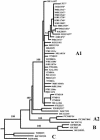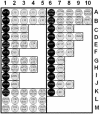Diversity of human immunodeficiency virus type 1 subtype A and CRF03_AB protease in Eastern Europe: selection of the V77I variant and its rapid spread in injecting drug user populations
- PMID: 15452247
- PMCID: PMC521816
- DOI: 10.1128/JVI.78.20.11276-11287.2004
Diversity of human immunodeficiency virus type 1 subtype A and CRF03_AB protease in Eastern Europe: selection of the V77I variant and its rapid spread in injecting drug user populations
Abstract
To characterize polymorphisms of the subtype A protease in the former Soviet Union, proviral DNA samples were obtained, with informed consent, from 119 human immunodeficiency virus type 1 (HIV-1)-positive untreated injecting drug users (IDUs) from 16 regions. All individuals studied have never been treated with antiretroviral drugs. The isolates were defined as IDU-A (n = 115) and CRF03_AB (n = 4) by using gag/env HMA/sequencing. The pro region was analyzed by using sequencing and original HIV-ProteaseChip hybridization technology. The mean of pairwise nucleotide distance between 27 pro sequences (23 IDU-A and 4 CRF03_AB) was low (1.38 +/- 0.79; range, 0.00 to 3.23). All sequences contained no primary resistance mutations. However, 13 of 23 (56.5%) subtype A isolates bore the V77I substitution known as the secondary protease mutation. V77I was associated with two synonymous substitutions in triplets 31 and 78, suggesting that all V77I-bearing viruses evolved from a single source in 1997. Hybridization analysis showed that 55 of 115 (47.8%) HIV-1 isolates contained V77I, but this variant was not found in any of 31 DNA samples taken from regions, where the HIV-1 epidemic among IDUs started earlier 1997, as well as in any of four CRF03_AB isolates. The results of analysis of 12 additional samples derived from epidemiologically linked subjects showed that in all four epidemiological clusters the genotype of the donor and the recipients was the same irrespective of the route of transmission. This finding demonstrates the transmission of the V77I mutant variant, which is spreading rapidly within the circulating viral pool in Russia and Kazakhstan. The continued molecular epidemiological and virological monitoring of HIV-1 worldwide thus remains of great importance.
Figures




References
-
- Ammaranond, P., P. Cunningham, R. Oelrichs, K. Suzuki, C. Harris, L. Leas, A. Grulich, D. A. Cooper, and A. D. Kelleher. 2003. Rates of transmission of antiretroviral drug resistant strains of HIV-1. J. Clin. Virol. 26:153-161. - PubMed
-
- Ammaranond, P., P. Cunningham, R. Oelrichs, K. Suzuki, C. Harris, L. Leas, A. Grulich, D. A. Cooper, and A. D. Kelleher. 2003. No increase in protease resistance and a decrease in reverse transcriptase resistance mutations in primary HIV-1 infection: 1992-2001. AIDS 17:264-267. - PubMed
-
- Balode, D., A. Ferdats, I. Dievberna, L. Viksina, L. Rozentale, T. Kolupajeva, T. Konicheva, and T. Leitner. 2004. Rapid epidemic spread of HIV type 1 subtype A1 among intravenous drug users in Latvia and slower spread of subtype B among other risk groups. AIDS Res. Hum. Retrovir. 20:245-249. - PubMed
-
- Bobkov, A., R. Cheingsong-Popov, L. Selimova, N. Ladnaya, E. Kazennova, A. Kravchenko, E. Fedotov, S. Saukhat, S. Zverev, V. Pokrovsky, and J. Weber. 1997. An HIV type 1 epidemic among injecting drug users in the former Soviet Union caused by a homogeneous subtype A strain. AIDS Res. Hum. Retrovir. 13:1195-1201. - PubMed
-
- Bobkov, A., E. Kazennova, L. Selimova, M. Bobkova, T. Khanina, N. Ladnaya, A. Kravchenko, V. Pokrovsky, R. Cheingsong-Popov, and J. Weber. 1998. A sudden epidemic of HIV type 1 among injecting drug users in the former Soviet Union: identification of the subtype A, subtype B, and novel gagA/envB recombinants. AIDS Res. Hum. Retrovir. 14:669-676. - PubMed
MeSH terms
Substances
Associated data
- Actions
- Actions
- Actions
- Actions
- Actions
- Actions
- Actions
- Actions
- Actions
- Actions
- Actions
- Actions
- Actions
- Actions
- Actions
- Actions
- Actions
- Actions
- Actions
- Actions
- Actions
- Actions
- Actions
- Actions
- Actions
- Actions
- Actions
LinkOut - more resources
Full Text Sources
Other Literature Sources
Medical
Molecular Biology Databases

